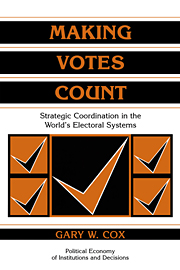Book contents
- Frontmatter
- Contents
- List of tables and figures
- Series Editors' Preface
- Preface
- PART I INTRODUCTION
- PART II STRATEGIC VOTING
- PART III STRATEGIC ENTRY
- PART IV ELECTORAL COORDINATION AT THE SYSTEM LEVEL
- PART V COORDINATION FAILURES AND DEMOCRATIC PERFORMANCE
- 12 Coordination failures and representation
- 13 Coordination failures and dominant parties
- 14 Coordination failures and realignments
- PART VI CONCLUSION
- APPENDICES
- References
- Subject Index
- Author Index
14 - Coordination failures and realignments
Published online by Cambridge University Press: 05 August 2012
- Frontmatter
- Contents
- List of tables and figures
- Series Editors' Preface
- Preface
- PART I INTRODUCTION
- PART II STRATEGIC VOTING
- PART III STRATEGIC ENTRY
- PART IV ELECTORAL COORDINATION AT THE SYSTEM LEVEL
- PART V COORDINATION FAILURES AND DEMOCRATIC PERFORMANCE
- 12 Coordination failures and representation
- 13 Coordination failures and dominant parties
- 14 Coordination failures and realignments
- PART VI CONCLUSION
- APPENDICES
- References
- Subject Index
- Author Index
Summary
Since V.O. Key's seminal work in the 1950s, the study of critical realignments has formed an important part of American political studies. Definitions of what critical realignments are vary from author to author but certain features recur in the literature: First, there are “short-lived but very intense disruptions of traditional patterns of voting behavior” in which “large blocks of the active electorate … shift their partisan allegiance”; second, there are disruptions of “the party nominating and platform-writing machinery,” leading to “transformations in the internal loci of power in the major party most heavily affected by the pressures of realignment”; and third, there are “transformations in large clusters of policy” (Burnham 1970:6, 7, 9). Critical realignments thus feature abrupt changes in voting, nominating, and policy-making strategy on the part of elites and voters.
The most dramatic examples of realignment entail the disintegration of a major party. When the Whig party fell apart in the 1850s and was rapidly replaced by the Republican party, large numbers of voters and politicians switched their allegiance, with profound consequences for the nation's politics. When the Liberal party in the United Kingdom fell apart in the 1920s and was rapidly replaced by Labour, again large numbers of voters and politicians switched their allegiance, and again the consequences for the nation's politics were profound.
The abruptness of the change in voter and elite strategies in these cases, and the patterned nature of the changes – with virtually all former Whigs going either into the new Republican or the reconstituted Democratic party, for example – indicates the element of coordination in realignment politics.
- Type
- Chapter
- Information
- Making Votes CountStrategic Coordination in the World's Electoral Systems, pp. 251 - 266Publisher: Cambridge University PressPrint publication year: 1997



